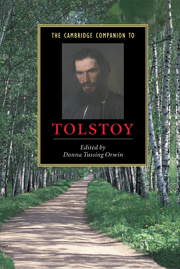Book contents
- Frontmatter
- Chronology
- Introduction
- Part 1 The three novels
- Part 2 Genres
- Part 3 General topics
- 7 The development of style and theme in Tolstoy
- 8 History and autobiography in Tolstoy
- 9 Women, sexuality, and the family in Tolstoy
- 10 Tolstoy in the twentieth century
- 11 Courage in Tolstoy
- 12 Tolstoy’s aesthetics
- Guide to further reading
- Index to Tolstoy’s works and characters
- Generel Index
7 - The development of style and theme in Tolstoy
from Part 3 - General topics
Published online by Cambridge University Press: 28 May 2006
- Frontmatter
- Chronology
- Introduction
- Part 1 The three novels
- Part 2 Genres
- Part 3 General topics
- 7 The development of style and theme in Tolstoy
- 8 History and autobiography in Tolstoy
- 9 Women, sexuality, and the family in Tolstoy
- 10 Tolstoy in the twentieth century
- 11 Courage in Tolstoy
- 12 Tolstoy’s aesthetics
- Guide to further reading
- Index to Tolstoy’s works and characters
- Generel Index
Summary
Most literary critics divide Tolstoy’s long and productive career into three periods, with the main one stretching from 1863, just after his marriage, when he settled into writing the novel that became War and Peace, to 1877, when he finished Anna Karenina. From this perspective, the monumental novels dwarf everything else: Tolstoy’s early works are seen as training for the Herculean task of writing those epics; his later works, with some exceptions, are dismissed as the suspect output of his restless old age, when Tolstoy was seeking ever new ways of using his pen to design the kingdom of God, to compose “for the people,” and, in general, to give answers to impossible questions (among them, “What is Art?”; “What Then ShallWe Do?”; “How Much Land Does a Man Need?”; “Why Do People Stupefy Themselves?”). Other critics who take a less literary point of view have shown greatest reverence for what Tolstoy did and wrote in his later period, after the “crisis” and “conversion” of the late 1870s, when being a humanitarian, vegetarian, wise man, moralist, and activist was more important to him than being the author of literature. The elderly Tolstoy himself tried to disavow his former selves, not just the Tolstoy who killed men in war, or the Tolstoy who committed adultery, but also the Tolstoy who composed works of literature for the educated classes in a vain desire for glory and profit. Because Tolstoy’s middle and late periods attract so much attention, his early works have to a degree been undervalued and neglected. In studying these works, however, we come to see, perhaps in its purest form, what is unique about Tolstoy’s writing. We see the stylistic and thematic originality that commanded the attention of his first readers, who were convinced, from the outset, that they were beholding a major new talent.
- Type
- Chapter
- Information
- The Cambridge Companion to Tolstoy , pp. 159 - 175Publisher: Cambridge University PressPrint publication year: 2002
- 2
- Cited by



